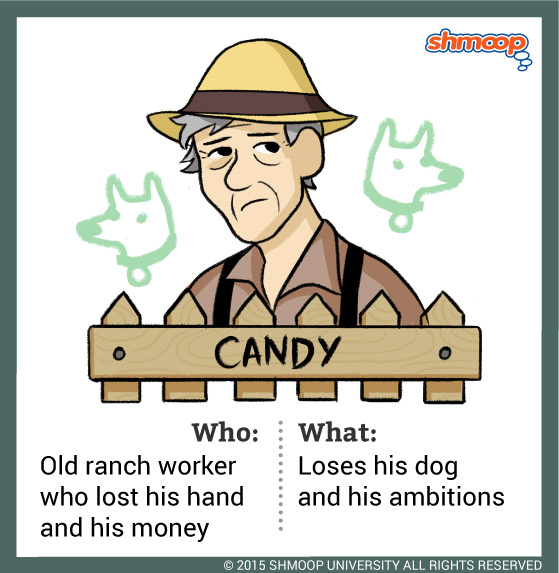Character Analysis

(Click the character infographic to download.)
Candy is an old ranch worker ("swamper") who has lost one of his hands in a farm accident. He's spent the best years of his life working on someone else's ranch, only to lose his hand and have little money. Depressing, right?
Wait until you hear the bit about the dog.
Man's Best Friend
Candy's dog was once a great sheepherder, but it was put out to pasture once it stopped being productive. Sound familiar? Candy realizes that his fate is to be put on the roadside as soon as he's no longer useful; his ranch boss won't treat him any differently than his dog.
Candy is actually worse off: unlike his dog, he's emotionally destroyed by the whole business. He can't bring himself to shoot his pet himself, even "squirming" uncomfortably when he talks about it: "Well-hell! I had him so long. Had him since he was a pup" (3.56). We suspect this is the same fear that keeps him from making anything more of his life. He can't stand up for his pet, because he can't stand up for himself.
No surprise, then, that Candy wants to change "George and Lennie's dream" into "George, Lennie, and Candy's dream." But he still has a bad case of futility. As he tries to help the men attain their dream, he also reminds them of the possibility (and indeed, likelihood) that it's going to fail—symbolized by his failure to kill his own dog. "I ought to of shot that dog myself," he tells George: "I shouldn't ought to of let no stranger shoot my dog" (3.234).
Maybe Candy is the novel's truly tragic figure, then. (There are definitely a lot of options.) After Lennie kills Curley's wife and everyone realizes that dream is bust, Lennie worries about the future rabbits, George mourns the fact that he's about to kill his best friend, and Candy is left to embody the despair of reaching the end of a long, hard-working life and being no closer to the American dream.
Plus, his dog is dead.
Candy's Timeline